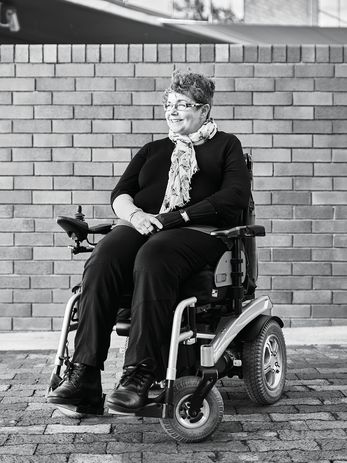
Wendy Lovelace.
Image: Toby Scott
I knew I wanted to be an architect from a very early age. When I reflect on my early childhood, I always enjoyed seeing the world in plan view. I got multiple sclerosis (MS) fairly soon after graduating from architecture and that has changed the way I live and the way I can work. So my career has evolved in access auditing in equity and inclusion. There is a great need for embracing of universal design, and as convenor of Queensland Action for Universal Housing Design (QAUHD), I think it’s really important that we get the word out and build support for mandating accessibility features in all new homes.
A house can be expected to stand for at least fifty to one hundred years and to be occupied by progressive generations of people with varying needs and abilities. At QAUHD we believe that a universal design approach will ensure that the homes we build today are capable of responding to the changing needs of occupants and visitors over time. A universally designed home is easy to enter and move around in and can be cost-effectively adapted if needs change.
My own illness has evolved while I’ve been living independently. For a decade I was living in an ordinary two-bedroom, ground-floor unit. I came across it when it was under construction. Luckily they hadn’t yet poured the slab for the garage areas, so they could build a path up to my front door, with no step. It was an open-plan design, spacious and easy to move around in. There were step-free bathroom areas, no step into the shower. Over time we were able to make simple modifications like putting grab rails up. When I moved in I was able to walk, just using a walking stick, and when I left I was in a wheelchair with very reduced ability to use my left hand, so my movements were significantly constrained, and my need to finally move out was really about safety.The National Disability Insurance Scheme (NDIS) produced massive expectations. When it was first talked about, many people thought, “I’m going to be able to have a house of my choice.” But the NDIS actually doesn’t cover anything to do with housing. It will, however, give people with a disability the opportunity to manage their own funding, and it’s there that the NDIS is powerfully positioned to assist people to stay in their own homes for longer. Housing is one of the most significant issues for people with a disability and there isn’t even close to enough accessible building stock to meet demand.
My preference is for people to make their own plans and live their own lives in their own homes. That’s what I would have liked for myself, except I wasn’t prepared for it properly. I didn’t understand how to build a circle of support and engage my friends in becoming part of that solution.
In “disability care,” if you want to categorize it as that, there’s a very vocal argument against group housing. The thing about communal housing is that as soon as you have something that’s more than a regular household, with people caring and people being cared for, it becomes a workplace rather than a home. When people are being cared for in their own homes, from the examples I’ve seen, those places retain the identity of home much better than places that are on a larger scale and more institutional. You can put all your doodads up and all your favourite things but as soon as a carer walks into your space it becomes a workplace, regardless of the kind of relationship you’ve managed to build up with your carers. Because if something goes wrong, it’s a workplace [laughs]. And that’s for the protection of everybody. So I find it very difficult to walk that fine line between something that’s institutional and something that’s not.
I live in Brisbane and I had some reservations about moving to an outer suburb, because it was remote and I was moving to another side of town, where I didn’t have connections. I had lived in an inner suburb that has a village feel and I’d joined a couple of book clubs. Things like that engage you with the community. It had a shopping and restaurant strip that was vibrant until nine or ten o’clock at night and was happening very early in the morning, with the bakery, from 5 am. So it was busy and I liked that.
I felt my new location was a suburb that closed down from early evening. People drive home and pull into their garage and the automatic door closes and that’s it, they’re inside for the night. There’s little activity beyond the front gate in this kind of suburb, other than walking dogs or running for exercise. It’s a dormitory suburb. I’ve stopped expecting interaction on the street, like there was where I lived before.
From here to the places I enjoy, it’s a fairly lengthy bus trip. I like public transport, but I wish I lived somewhere with closer access to the train or the CityCat ferry because both of those are relatively easy to get on and off and cater well for people with disability. Buses are a bit more difficult. I work in Woolloongabba, so for that trip to be efficient I get a cab from door to door and that’s anywhere from forty minutes to an hour and costs between $50 and $75, depending on the traffic, and that’s each way. So my first hour of pay goes on getting me to work.
What I’d really like is to live close to the city, close to South Bank, close to public transport so that I can move around more easily. I think there’s an opportunity with highrise towers being built in inner suburbs at transport nodes. With accessible design, quite a lot of people with disability could come into those places. Often the choice narrows for people with a disability, because there’s very little accessible and affordable housing stock available.
Access to and through public buildings is getting better, especially since the Disability (Access to Premises – Buildings) Standards 2010 were included in the Building Code of Australia of 2010. But we still have a problem with housing, where people are locked into their homes or locked out of their friends’ homes simply because they’re not accessible. That’s my new quest, to have as much fully accessible housing as possible. Clearly there will be some exclusions for particular sites, but a huge amount of our housing product can be made accessible. It could be mandated through the Building Code of Australia, but there has been strong resistance by the industry.
That’s one of the things I work on at QAUHD. We report to the national body, which is the Australian Network for Universal Housing Design, and they have done two important things to try to overcome industry resistance to mandating. They’ve made an application to Standards Australia to rewrite one of the Australian Standards, AS 4299–1995 Adaptable Housing, to bring it more into line with the Livable Housing Design Guidelines. And they’ve applied to have accessible features put into the Building Code of Australia.
Many builders and developers say there’s no demand for accessible features, but I think that’s based on a denial, among buyers, of the effects of ageing. There is an unwillingness to include features that admit to ageing and injury and inability to do things. A beautiful, simple, barrier-free home is enticing but not if those features are sold as anti-ageing or anti-injury. It’s not strong marketing to say, “We have no steps inside to trip you up,” but on the other hand it is to say, “Lovely open-plan design with an easy flow from inside to out.” That’s seductive.
There are things you can achieve easily during construction that really assist the evolving use of the house. It can be very simple – putting some reinforcing or lining behind the wall sheeting in the bathroom so you can put supportive rails up and take them down. It’s at minimal cost. If only people had the knowledge and foresight to do that. QAUHD is advocating for those simple things to be included in every new or renovated house.
A lot of it is just habit. Notionally that step at the front door is to keep termites and water out. Water you can manage with grading, or by putting water collection further out from the face of the building. And termite protection can come in other forms, even the simplest ways – creating a gap where you can do visual inspections. Same with showers – you can set down areas in the slab, or you can set down some of the floor framing to create a step-free wet area. It’s just a matter of thinking about it and not going with the habit we’ve gotten into.
Barrier-free access is important to everybody, not just those on wheels. People in wheelchairs are the most obvious but there are so many others who benefit.
The Australian population is not only the able-bodied, the white, the middle-class. These may be the people who can afford to buy new houses, though, and the people at whom everything is marketed. Whereas people who are ageing, people with a disability, people who are immigrants – they have very little money and they’re trying to be part of the community but they’re excluded through housing types, housing availability, housing affordability. And so a divided society is created – the gap just gets bigger and bigger.
Source

Discussion
Published online: 5 Dec 2016
Words:
Wendy Lovelace
Issue
Architecture Australia, September 2016














